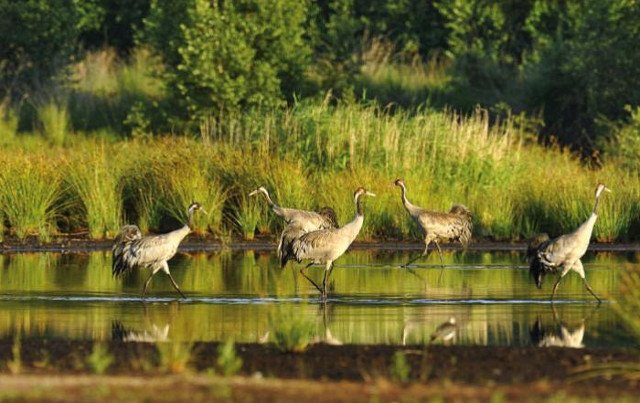“Hidden” under the treasure of … protected areas of the country there are revenues for the state treasury of 2 billion euros per year. According to a new study by diaNEOsis, carried out in collaboration with the Natural Environment and Climate Change Organization (OFYPEKA) and published today, this money will flow into the Greek economy if 40% of Natura 2000 areas in country recognized and used as the case of other European countries. At the same time, it will get more than 15,000 jobs.
The network of Natura protected areas covers approximately 27% of the land, including important habitats (eg Prespa wetlands, Rhodope forest, marine park of the Mediterranean seal Monachus monachus in the Sporades, etc.) . However, Naturas is not only important for the conservation of ecosystems and wildlife but also for local social and economic development by promoting soft forms of tourism (eg ecotourism). In fact, as pointed out in the study (a continuation of the corresponding one from 2017), which was signed by the researchers of Harokopei University (with the scientific responsible for the emeritus professor of Tourism Development Mr. Pari Chartas) and the University of the Aegean and Western Attica, “the mild economic activity of the territory possibly giving them additional incentives to ensure their protection”.
In general, it is estimated that at an annual cost of 148.5 million euros, the management and protection of Natuta areas in Greece will provide annual benefits of the order of two billion euros. The total budget estimate for sustainable tourism development actions in Natura 2000 sites (conservation and restoration measures, green infrastructure, administrative costs, etc.) in Greece reaches 1,039.5 million of euros for the seven-year period 2021-27.
Available financial tools 7.7 billion euros
According to the researchers, the necessary interventions can be integrated into the financial programs available for Greece in the current fiscal framework. The new NSRF, the Recovery and Resilience Fund (Resilience Fund), the Life 2021-2027 program, the Common Agricultural Policy (CAP 2023-2027) and the European Territorial Cooperation (Interreg) have a decisive role in finding of appropriate financial instruments.
The new NSRF introduces significant additions related to the actions of Natura 2000 areas, compared to the previous period, through the 6th priority, budget of 74 million euros, in the Environment program and Climate Change, the 3rd priority, budget of 71 million euros, in the Fisheries, Aquaculture and Sea program and through Integrated Spatial Investments (OCE), with a total budget of 414 million euros, in Operational Regional Development programs.
The Recovery Fund is another key source of funding, with a 1.8 billion euro “purse” for green growth, while Life 2021-2027, with a budget of 5.4 billion euro, and Interreg also focus in actions to promote tourism in protected areas of Natura. 2000 network.
Ticket Policy
European investment funds in Natura can be combined, according to researchers, with more efficient commercial exploitation of protected areas.
Example of:
– the ticket policy is the same as in the Samaria gorge and the Sporades park
– the provision of services (eg organization of sports and social activities or excursions)
– the sale of local products.
Return on investment
Entrance fees paid by tourists when they visit protected areas provide direct revenue to states, while money they spend on hotels, food, transportation, souvenirs, and other tourism services boosts local economy. “When calculating the amount of these direct and indirect economic benefits, an estimate of the rate of return on public investment in protected areas and nature-based tourism is provided,” says the report, which examines the example from four countries. Brazil, Fiji, Nepal and Zambia, and found the benefits from investing in protected areas far outweighed the cost of the initial investment. The rates of return are:
• 6 times the amount invested for the Abrolhos Marine Park in Brazil.
• 8 times the amount invested for Chitwan National Park, Nepal.
• 16 times the amount invested for the Lower Zambezi National Park in Zambia.
• 28 is the amount invested in South Luangwa National Park in Zambia.
The intensity of tourism
In any case, there are restrictions on the type and intensity of tourist activity in Natura areas depending on the protection zone. The types of tourism considered suitable are ecotourism (hiking, bird watching, tours, etc.), agrotourism (participation in agricultural activities, eg olive harvest) and cultural tourism (visiting monuments, museums, and others).
However, the challenges are many. Even with such mild activities the burden on the environment (pollution, disturbance to wildlife, etc.) can be significant. Another problem concerns the preservation of the true experience of local culture, in the conditions of the great development of tourist activities. Another challenge highlighted in the study is the creation of adequate infrastructure (roads, disabled access, etc.) to handle visitor traffic. Visitors should also be informed about the protection of these areas.
Policy proposals
The researchers studied examples of protected areas in Greece (National Parks of Alonissos, Helmou-Vouraikos, Dadia-Lefkimis-Soufli, Lake Kerkini, Messolonghi-Aitoliko Lagoon, Olympus and Elafonissos) and abroad (Ambrutso) Mountain Complex in Italy, Azores Archipelago in Portugal. , Camargue wetland in France) that have developed tourism activities to a greater or lesser extent. According to the conclusions of cases abroad, sustainable tourism within protected areas is sufficiently developed through the synergy of competent tourism bodies, bodies responsible for promoting sustainability, local bodies and tourism business. On the contrary, in Greece a patchy application of different management tools emerged.
For the formation of a model of sustainable tourism in protected areas in Greece, the study group proposes a toolbox that follows the ten principles of sustainable tourism and adapts the proposed strategies and actions to the case of Greece. These actions are identified as having to do with strengthening the management framework, operational capacity, promotion and promotion, reducing the environmental footprint, providing quality tourist products, supporting the local economy as well as strengthening on local cooperation. community and tourism agencies for achieving the goals of sustainable tourism.

